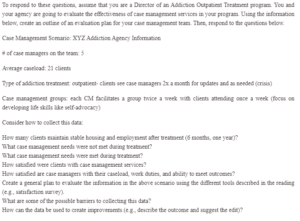Evaluation of Services
An evaluation plan enables the monitoring and assessment of a project to determine its success. It provides a framework that will be used to monitor the project and how its objectives will be fulfilled. Evaluation plans can either be summative or formative. Formative programs evaluate both ongoing and upcoming events. It evaluates events from initial developmental stages until they are implemented. Summative evaluation occurs at the end of a project. It considers whether the set goals were achieved. It also contains details of any unprecedented event that arose during the project.
The development of an evaluation plan can be accomplished in four steps. The first step involves setting the goals and objectives of the program (Sandra, 2018). The next step is the creation of evaluation questions. The third step is the development of evaluation methods. The last step is developing a timeline for the entire program (Sandra, 2018). The goal of the program is to manage addiction in outpatients. The project has various evaluation questions. Different evaluation methods for the questions can be used.
Data on the number of clients maintaining stable housing and employment will be collected using member surveys and interviews. Online surveys will be sent to the participants after six months of treatment and at the end of treatment. The goal attainment report will be used to collect data on the case management needs achieved during treatment and those that were not met. Each of the 5 case managers should generate this report. Satisfaction surveys will collect data on the level of satisfaction of clients with the services provided. Satisfaction surveys will also be used to evaluate the level of satisfaction of case managers with their caseloads and work duties.
Different barriers to the collection of data exist. The first barrier is the failure of the participants to respond to the surveys (Rubinfeld & Gal, 2016). Some of the participants can fail to provide feedback. The data obtained will not be representative of all participants. When interviews are used for data collection, the process is time-consuming (Summers, 2016). The other barrier is that participants may give falsified feedback.
Collected data can be used to make improvements. An example is data on the level of satisfaction of clients with the services provided. The case managers will use this feedback to modify their treatment program. If the participants are dissatisfied with the number of days they attend the program, more days can be added or deducted. This helps to fulfil the client’s expectations and make them benefit maximum from the program.
References
Sandra, O. R. (2018). Designing the evaluation plan.
Rubinfeld, D. L., & Gal, M. S. (2016). ACCESS BARRIERS TO BIG DATA.
Summers, N. (2016). Fundamentals of Case Management Practice Skills for the Human Services. Cengage Learning.
ORDER A PLAGIARISM-FREE PAPER HERE
We’ll write everything from scratch
Question
To respond to these questions, assume that you are a Director of an Addiction Outpatient Treatment program. You and your agency are going to evaluate the effectiveness of case management services in your program. Using the information below, create an outline of an evaluation plan for your case management team. Then, respond to the questions below.

Evaluation of Services
Case Management Scenario: XYZ Addiction Agency Information
# of case managers on the team: 5
Average caseload: 21 clients
Type of addiction treatment: outpatient- clients see case managers 2x a month for updates and as needed (crisis)
Case management groups: each CM facilitates a group twice a week with clients attending once a week (focus on developing life skills like self-advocacy)
Consider how to collect this data:
How many clients maintain stable housing and employment after treatment (6 months, one year)?
What case management needs were not met during treatment?
What case management needs were met during treatment?
How satisfied were clients with case management services?
How satisfied are case managers with their caseload, work duties, and ability to meet outcomes?
Create a general plan to evaluate the information in the above scenario using the different tools described in the reading (e.g., satisfaction survey).
What are some of the possible barriers to collecting this data?
How can the data be used to create improvements (e.g., describe the outcome and suggest the edit)?

